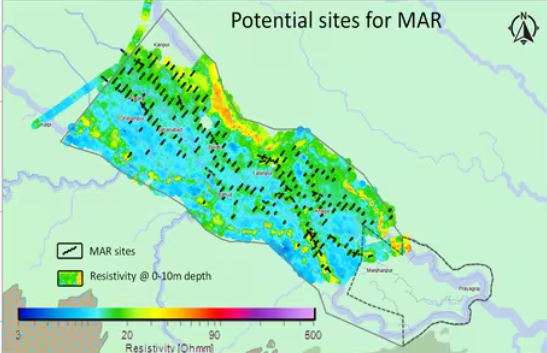Uttar Pradesh Switch to Hindi
Ancient River Unearthed in Ganga-Yamuna Doab
Why in News?
A major aquifer mapping project under the National Mission for Clean Ganga (Namami Gange) in Prayagraj has uncovered a long-lost ancient river in the Ganga-Yamuna Doab, stretching between Prayagraj and Kanpur.
Key Points
- About: The paleo-channel mapping revealed the river spans around 200 kilometres in length, about 4 kilometres in width, and 15 to 25 metres in depth.
- Method: Satellite imagery and geospatial data were used to trace the river’s ancient route and map subsurface water reservoirs.
- Potential: The ancient river has a water storage potential of nearly 3,500–4,000 million cubic meters (MCM).
Aquifer Mapping Project
- About: The aquifer mapping project, supported by cutting-edge technologies such as smart water management systems, remote sensing, and drone-based monitoring, is playing a crucial role in the sustainable rejuvenation of the Ganga.
- Implementation: The project is being carried out in collaboration with the Uttar Pradesh State Groundwater and Irrigation Department.
- Managed Aquifer Recharge (MAR) Sites: Over 150 MAR sites have been identified, where recharge structures will be constructed to boost groundwater levels and maintain the river’s baseflow.
- Phases: The project’s first phase will focus on developing 20-25 MAR sites. These recharge structures, each measuring 5m × 5m × 3m, are designed to improve groundwater levels, supporting the flow of water in the river.
- Technology: With the installation of automatic water-level indicators by the Council of Scientific & Industrial Research, National Geophysical Research Institute (CSIR-NGRI), real-time scientific monitoring will ensure the success of the recharge efforts.
- Significance: These initiatives aim to mitigate climate change and water scarcity while preserving the Ganga and other rivers for future generations, providing long-term solutions through subsurface reservoir systems and advanced technologies.
National Current Affairs Switch to Hindi
World Duchenne Muscular Dystrophy Day
Why in News?
The Department of Empowerment of Persons with Disabilities (DEPwD), Ministry of Social Justice & Empowerment, Government of India, observes World Duchenne Muscular Dystrophy Day every year on 7th September.
Key Points
- About: The UN General Assembly designated 7 September as World Duchenne Awareness Day starting in 2024.
- The day focuses on fostering global solidarity, awareness, and empathy towards affected individuals and families.
- Theme 2025: This year’s theme, “Family: The Heart of Care,” highlights the vital role of families in providing love, support, and resilience for those with DMD, while fostering inclusion, awareness, and community support.
Duchenne Muscular Dystrophy (DMD)
- DMD is a rare, progressive genetic disorder caused by mutations on the X chromosome leading to the absence of dystrophin, a muscle-protecting protein.
- It is named after Dr. Duchenne de Boulogne, who detailed the condition in the 1860s.
- This primarily affects males, as they have a single X chromosome.
- Symptoms begin with difficulty in walking, followed by progressive weakening of motor functions.
- Over time, the disorder affects the ability to breathe and impacts the heart (a muscle itself).
- Dystrophin also plays a role in the brain, which can lead to learning and behavioral challenges.
- The average age of diagnosis globally is above 4 years, with a diagnostic delay of ~2.5 years despite parents noticing symptoms earlier. Some symptoms may appear in very young children.

.gif)

.png)
















.png)


.jpg)



 PCS Parikshan
PCS Parikshan


